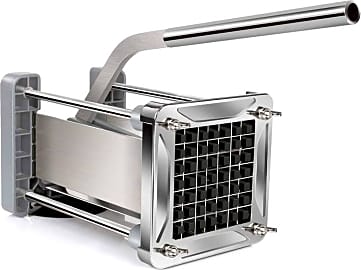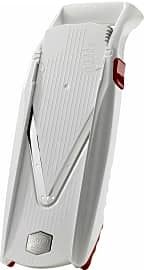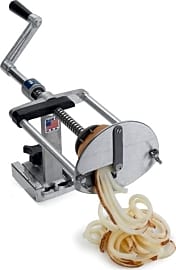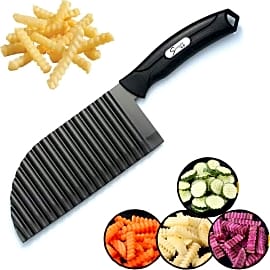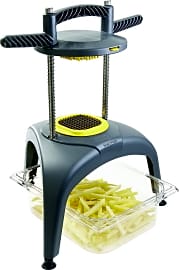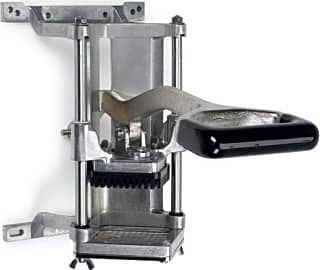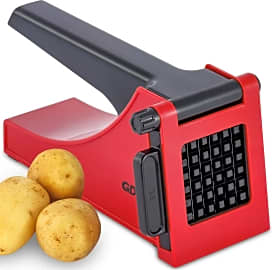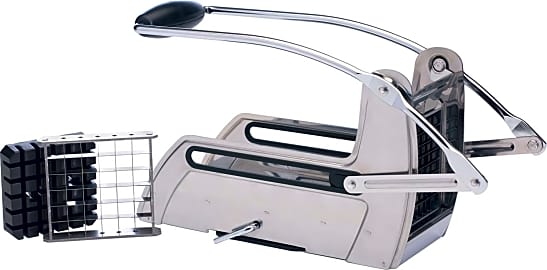The 10 Best French Fry Cutters

This wiki has been updated 41 times since it was first published in April of 2015. We're pretty sure that whether you call them chips, pommes frites, or French fries, you will agree they are among the best foods in the world when they are home-made. But who wants to stand in the kitchen for hours cutting pounds of potatoes? Well, you won't have to if you use one of these fry cutters, which make short work of a bag of spuds and provide consistent results. When users buy our independently chosen editorial recommendations, we may earn commissions to help fund the Wiki.
Editor's Notes
November 25, 2020:
Whether you eat fries all the time or only occasionally, you'll find an option to suit your needs here, as we've kept a range of heavy-duty, pricey models and lightweight choices for casual use.
When it comes to robust choices, the New Star Foodservice is still one to beat thanks to the stability it offers, as well as the range of cutting accessories available. The Sopito V6 also retains a top spot; its strong metal construction ensures that it lasts, and it has a large cutter box to lessen the amount of prep you might need to do. For commercial needs, there's the Nemco Easy, which is NSF certified.
If you'd prefer the versatility of a mandoline slicer, look to the Swissmar Borner VPower, which takes the place of the Progressive International model. The blade on the Progressive model seems to dull too quickly, a problem from which the VPower doesn't suffer. In fact, it's a useful tool to have around for preparing all kinds of veggies, but keep in mind that these tools require respectful, careful use so that you don't slice a finger inadvertently.
As to models made for lighter duty, we added the GDL Chopper and opted for the Prepworks by Progressive Deluxe instead of the non-deluxe version. These don't pack as much oomph as many pricier choices, but for occasional use, they should be fine. Just note that they aren't the best for very hard, fibrous vegetables, including sweet potatoes. If you're really determined to cut a yam or similar, try microwaving the vegetable for a minute or two first to soften it up.
December 06, 2019:
Which french fry cutter you choose depends largely on how much use it will be getting, but also on the type of fries you're making. The ZZ Pro ZV0024 and Nemco Ribbon can both create interesting-looking and flavorful spiral fries, but they are of course unable to make standard steak fries.
If you're looking for a more traditional shape, the Progressive Prepworks is just about the least expensive option. The Sopito V6 is only a bit more costly, though, and its all-metal construction inspires quite a bit more confidence in its durability. The New Star Foodservice and TMS Commercial are both a step up, both price-wise and in terms of performance. They're made with ultra-thick metal and both look and feel like they would fit in a professional environment. They're also both interesting because they come with full complements of plates for various sizes of fries and wedges. The New Star includes suction cup feet while the TMS is designed to be bolted down.
If you're able to make a more significant investment, the Nemco Easy can handle larger workloads than pretty much any other manual option; in fact, it's the exact model found in many ultra-high-volume pro kitchens and commissaries. The Matfer Bourgeat, which is even more expensive, is set apart by its dual ergonomic handles, so if you're having trouble getting through sweet potatoes on a regular basis, it might be the one for you. Meanwhile, the Nemco Monster Airmatic is incredibly expensive, but it does all the work for you; if you have multiple 50-pound bags to go through and you're sick of hurting your shoulder, it may be worth a look. Once you've selected the right one for you, make sure you have a good deep fryer, or, if you're running a professional enterprise, a commercial-grade one.
Special Honors
Nemco Monster Airmatic FryKutter The Nemco Monster Airmatic FryKutter lives up to its name by pneumatically processing up to a whopping 720 potatoes per hour. It's specifically designed to reduce labor costs for large-volume operations, like gastropubs and catering companies, and it won't fatigue the operator. nemcofoodequip.com
How A French Fry Cutter Works
Some models act as general vegetable slicers and can create specialty cuts like spirals and ultra thin chips.
Standard french fry cutters have a blade tray that performs the slicing, and a container that holds the vegetable and pushes it through the blades. One end of the container consists of tiny steel teeth that the user inserts into the top of the potato for a better grip. Some models come with interchangeable blade trays so the user can cut different types of fries like shoe string, wedge, and steak. It’s always advisable to cut the round ends of the potato off before placing it on the blade tray, so that it sits flat against the cutting mechanism, making it easier to slice into.
These mechanisms are typically made from stainless steel, a material that has many advantages including ease of cleaning and its anti-corrosion properties. Plus, pieces of vegetable don’t stick to it the way they can on other materials. More compact varieties contain just two simple blocks — one that holds the potato and one that contains the blade tray — that fit inside one another. Advanced models resemble a deli meat slicer, with anti-slip feet holding up steel rods on which the potato holder and slicer slide towards each other. The latter usually have special handles that minimize the amount of pressure the user has to apply to cut the fries.
Some models act as general vegetable slicers and can create specialty cuts like spirals and ultra thin chips. These generally come with different sized blade trays to accommodate thinner items like carrots, as well as wider items like eggplant. Many models have either a built-in receptacle to catch the vegetable slices or are elevated to make it easy for the user to slide a tray underneath them.
The History Of French Fries
There is much debate over what country created the french fry, but most historians credit the Spanish with introducing the potato to Europe. In 1573, Spanish explorers came upon a Colombian village where they tried several native foods for the first time, including potatoes. Belgians are often referenced as the first french fry makers since they began frying thin pieces of potatoes in the 17th century. Tiny fried fish used to be a staple dish in most Belgian’s diets, but when the rivers would become too frozen, people would cut potatoes into small pieces and fry these up in place of the fish.
Once the potato became popular, street vendors began selling french fries out of push carts in major metropolitan areas, like Paris.
Since Spain controlled most of Belgium during the same years of the fried potato stories, it’s believable that the latter country had access to potatoes before the rest of Europe. However, the french fry naturally has roots in France, too. The French initially only used potatoes to feed livestock, since they believed the vegetable could make humans sick.
Potatoes were even once banned in the country for human consumption. After a French doctor named Antoine-Augustine Parmentier became a prisoner of war in Prussia and was forced to eat only potatoes, he realized the many benefits of the food. In the late 1700s, when Parmentier returned to France, he started spreading the news about the potato as a viable food source for humans.
To build intrigue around the vegetable, Parmentier hired guards to stand around his potato patches. This plan worked and some French individuals would offer the guards bribes to try the potato. Once the potato became popular, street vendors began selling french fries out of push carts in major metropolitan areas, like Paris.
How Fries Are Served Around The World
French fries have very different reputations and are associated with quite diverse types of foods, depending on where one eats them. In the United States the french fry isn’t considered very healthy, and typically accompanies fast food like hamburgers and hot dogs. In Scandinavia, where eating fish is an age-old tradition, french fries might accompany low-fat catches like plaice, or even a more high-end item like an entrecote, which is a premium cut of beef. Many countries in Europe, like parts of Scandinavia and France, have street vendors selling french fries on their own out of carts.
Canadians are known for their famous poutine, which comes from the french region of Quebec.
Belgium has entire shops called friteries dedicated to french fries. The item comes with several Belgian sauces and is eaten alone or with Belgian snacks like the frikandel — a minced meat sausage — or burgers. The large variety of sauces includes aioli, sauce Andalouse, sauce Americaine (which is a tomato-based, buttery dressing), curry mayonnaise, peanut sauce and even tartar sauce. Belgians also like to eat their fries with hot sauce or gravy.
Canadians are known for their famous poutine, which comes from the french region of Quebec. The dish features french fries smothered with cheese curds and topped with gravy. The item is so popular that major Canadian cities like Montreal and Toronto regularly host a Poutine Week, during which time restaurants and chefs can showcase their greatest items featuring the food. Dishes range from sophisticated plates like meatball stew poutine to unexpected creations like chocolate breakfast poutine. La Poutine Week recently went international and can be found in Australia, Brazil, and the United States.


